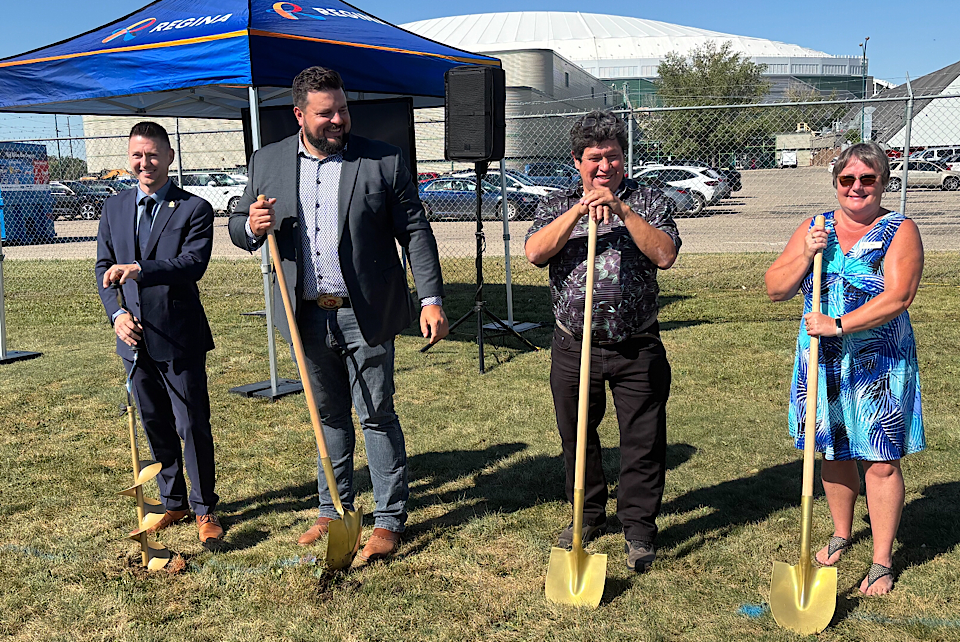REGINA — After years of discussion, debate and many city council meetings, the sod has been turned for the new indoor aquatics facility in Regina.
Officials including Mayor Chad Bachynski and Minister of Government Relations Eric Schmalz broke ground Tuesday morning at a ceremony on the site, located at the Sportsplex at 1717 Elphinstone St., just behind the Lawson Aquatic Centre.
The new facility will be much larger and have more features than the current Lawson Aquatic Centre. According to a city news release, it will include two 50-metre pools to host national competitions, as well as leisure amenities including a wave pool and waterslides, dryland training spaces, community spaces, and an outdoor play structure and spray pad.
The project is being built at a cost of $285.1 million, with an additional $28.5 million for the geothermal heating facility. All three levels of government are contributing, with $51.2 million from the federal government, $42.7 million from the provincial government and $219.7 million from the City of Regina.
The rising cost of the project has been a point of contention over the past several months, with the project becoming an election issue and a frequent subject of debate and votes at council.
Now that the shovels are finally in the ground, officials involved in the project say they can breathe easier.
“Yeah, excited, relieved that we got to this point where we actually moved some dirt today and that we can really feel the project starting to come alive now that we've broken ground,” said Mayor Chad Bachynski.
“It's an incredibly exciting day for the community, for Regina, and it just shows that Regina deserves nice things.”
Bachynski was asked about the prospect that the facility could help attract more major events down the road.
“I wouldn't say anything's guaranteed, but I know there's already conversations happening and I know there's definitely an excitement in the swim community to what this facility would mean on a national level to be able to provide additional aquatic space.”
The facility will be powered by a state-of-the-art geothermal heating facility, using a novel process of extracting hot water from the earth. Erik Nickel, chief operating officer of PTRC Sustainable Energy, explained how it will work.
“There will be water pumped up from that deep water source, moved through a heat exchanger, [similar to] a boiler. So it's going to go through a heat exchanger, and the water that it heats up on surface will then be the water that is in the pools and used to heat the facility. So it's not that the deep water is coming up and going in the pools, it's just being used to heat.
“Once the heat has been harvested from that hot water, it goes down a disposal well into the same formation a kilometre away. So it's just one big loop, and that loop can sustain itself with unlimited hot water for at least 70 years, according to the modelling that we've done.”
He said the geothermal wells will likely be drilled in spring or early summer of next year, and will be installed before the rest of construction begins in earnest.
“There will be two wells on surface that are less than 10 metres apart, but in the subsurface, they'll be ... over a kilometre apart, because of directional drilling. And what I'd like to stress is that the geothermal aspect here very much builds upon all the expertise that we have in Saskatchewan for drilling.”
Minister Schmalz spoke of the importance of recreational facilities such as this one to communities throughout the province.
“People need focus, need to be able to have outlets to be able to have a sense of community. And I think facilities like this provide that,” said Schmalz.
“Kids grow up in communities that have these facilities, they develop a moral compass, they develop a sense of community, direction, drive, focus, to be able to give them the tools to succeed in life.”
The province’s contribution came through the Investing in Canada Infrastructure Program, in partnership with the federal government. That program is ending, and Schmalz continues to call on the federal government to create a replacement to fund more community projects.
“We're continuing to advocate on behalf of the municipalities in this province, advocate to the federal government that we would like to see a replacement of this program or a program like this one, to have the flexibility to be able to provide opportunities for municipalities to invest in their communities, build high-quality, good projects like this one, and be able to provide that to the citizens of their municipalities and the people of this province.”


.png;w=120;h=80;mode=crop)

